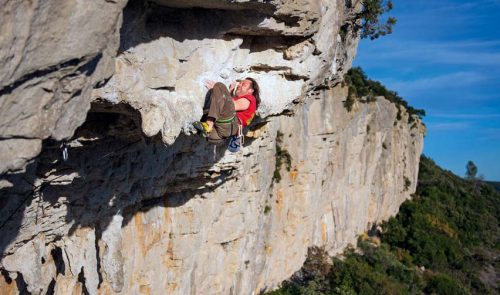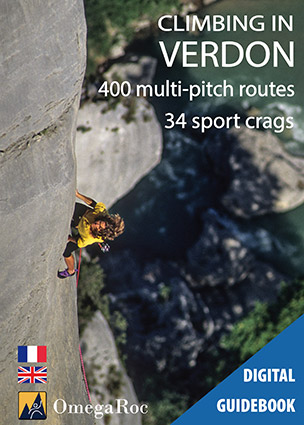
Climbing in the Montpellier Region
A stone’s throw away from the highly renowned sites of the Southeast France, the hinterland around Montpellier holds many beautiful sport crags as well as several slightly higher cliffs, mainly frequented by local climbers.
The digital guidebook Climbing in THAURAC
See the guidebook in the OmegaRoc app
Thaurac is the largest climbing site in the Montpellier region. The cliffs rise on both sides of the Hérault gorges, offering a wide variety of climbing styles, difficulty levels, and most importantly, orientations that allow everyone to climb throughout the year. This guidebook is the digital version of the ‘Escalade au Thaurac’ guide, regularly reissued and updated since 1989. It features over 1200 routes spread across around fifty sectors.
Each sector is illustrated with photos displaying clear and precise route outlines, while approaches are illustrated with panoramic photos for effective orientation.
The guidebook is produced by Fabien Roumanille and Loïc Le Denmat, two of the most active route setters and maintainers at Thaurac.
The profits generated from the sale of this guide are partially allocated to the maintenance and development of the region’s cliffs.

The climbing development in Thaurac
It all started in the 1960s, and it’s, of course, on the highest faces (La Grande Face and L’Euzière) that it all began, with pitons, aiders, and nuts. Many of the historic routes, consisting of 3 to 5 pitches, have been re-equipped* and are regularly climbed. Others, less interesting routes, have been forgotten, and hence partially disappeared under more recent openings.
Since the 1990s, single-pitch sectors have multiplied. The most significant ones are found on the left bank of the Hérault gorges (le Mur des Lamentations) and around the Grotte des Demoiselles cave. The more accessible routes, and there are plenty of them, ascend beautiful grey limestone, often technical but sculpted with edges, cracks, flakes, and pockets. When the rock leans more, the limestone becomes ochre and is covered with more or less prominent concretions. Climbing is demanding, and route reading isn’t always straightforward. Very steep overhangs are rare, but you can still find some beautiful bulges or roofs for enthusiasts.
* Some classic multi-pitch routes are to be trad climbed or partially equipped.
Other must-visit cliffs in the region:
Claret
Claret is the only true international-known site. With approximately 200 routes and about thirty meters high, it’s a pure sport crag. The average difficulty level is high, revolving around 7a/7b. On this stratified rock resembling a gigantic, inverted staircase, climbing is demanding, typically overhanging with some great roof sections. And to add to the challenge, the legendary commitment needed is not just a tale.
To learn more about Claret: RockAroundTheWorld

Saint-Bauzille-de-Montmel
Near Montpellier, Saint Bauzille-de-Montmel (referred to as Saint Bau by locals) is another significant cliff suitable for climbers of all levels, from beginners to advanced. The climbing is technical, on vertical walls with small (even very small) holds. Numerous routes with a more inclined profile will delight climbers from 5a to 6a level.
To learn more about Saint-Bauzille-de-Montmel: RockAroundTheWorld

Saint-Jean-de-Buèges
The high cliff of Saint-Jean de Buèges overlooks the magnificent small medieval village of the same name. As often seen in the region, both single-pitch routes and multi-pitch routes coexist. Climbing is diverse, and pretty committing in the multi-pitch routes. The various orientations allow for climbing throughout the year.
To learn more about Saint-Jean-de-Buèges: RockAroundTheWorld

The Hortus cliff
With its hundred meters in height, L’Hortus is primarily a cliff of ‘short’ multi-pitch routes. Short, but rather challenging on excellent compact and vertical rock. Some climbers prefer not to continue after the first belay station, considering L’Hortus as a highly appealing sport crag.
Some topos (inn rench): Topo-Thaurac

The Pic Saint-Loup North face
The North face of Pic Saint Loup is directly facing L’Hortus, filled with numerous mostly historic multi-pitch routes. The gear placement here is mixed, and cams and nuts are essential to bridge the gap between more or less aged pitons. Moreover, situated halfway up the wall, there’s Baume des Escargots, an immense cavity filled with tufas and extremely difficult routes. Here, warming up starts at grade 7 and climbing goes up to grade 8 or 9!
To learn more about La Baume des escargots (in french): Outdoor experience

Saint-Guilhem-le-désert
Located northeast of Montpellier, this limestone cirque overlooking the village of Saint-Guilhem-le-Désert hosts numerous multi-pitch routes ranging from 150 to 200 meters high. Spread across two main walls facing North (La Bissone) and Southeast (Le Cirque du Bout du Monde), the routes allow climbing all year round except for cold winter days. The climbing here is rather physical (especially at La Bissone), and most routes require the use of nuts and cams. In the Cirque du Bout du Monde, a few single-pitch sectors have emerged. Again, nothing easy…
To learn more about Saint-Guilhem-le-Désert (in french): Topo-Thaurac

In addition to these major sites, the hinterland around Montpellier offers many smaller cliffs that are great for spending a day: Valflaunès, Saugras cliff, Clocheton des Matelles, Joncas…
It happened in the Montpellier region…
Beautiful pictures of Lianes du temps , a great classic at moderate grade at La Grande Face (Thaurac).
English subtitles
Much harder: An episode of the Hidden Gems serie. Seb Bouin climbs at the Epingle à cheveux crag (Thaurac)
English subtitles
The crazy history of slacklining across the Herault gorges: Mythic!
English subtitles
Nina Caprez and Cédric Lachat climb at the Baume des escargots
English / English subtitles
Explore the crags in the neighborhood
Here are somme digital guidebooks for climbing in the surroundings areas.
To see all the guidebooks available on the OmegaRoc app: The OmegaRoc guidebooks
Acknowledgments:
Thanks to Sam Bié, Yves Mariaud and Cathrine Coq for allowing us to use their photos to illustrate this internet page.




